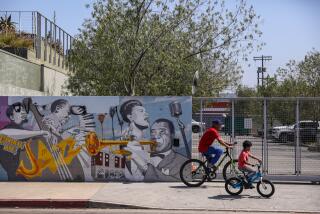Record number of Latinos eligible to vote, but midterm clout limited
A record number of Latinos are eligible to vote this year, but despite the rising numbers, Latino political clout will be sharply limited in the upcoming midterm election, according to a detailed new study.
Very few of this year’s competitive races take place in states with significant Latino populations, according to new data from the Pew Research Center. Moreover, compared with blacks and non-Hispanic whites, Latinos continue to lag behind in voter turnout, in part because their population skews notably younger than other groups, the report shows.
The number of Latinos eligible to vote -- citizens at least 18 years old -- has increased to 25.2 million, or 11% of the national total. That’s up from 10% in 2010 and less than 9% in 2006, and fits a pattern of steady increase in Latino political influence nationwide, the data show.
But Latinos are heavily concentrated in a handful of states. Nearly half of Latino potential voters live in Texas and California, and two-thirds in those two states plus Florida, New York, Arizona and Illinois. None of those six states have highly competitive Senate races this year, although Florida, Illinois and Arizona have hotly contested races for governor.
In the eight states with the closest Senate races, the Latino potential voter population averages well under half of the national average, at 4.7%. Of those states, only Colorado, at 14%, has a Latino potential voter population at or above the national average. The competitive state with the second-highest Latino share is Kansas, at 6%.
Among the country’s relatively few competitive congressional districts, only eight have Latino potential voter populations at or above the average, including three in California, two in Arizona and one each in Florida, Colorado and Illinois, the report says. The three California districts are the 7th in the Sacramento area, the 26th in Ventura County and the 52nd which covers northern San Diego.
In addition to being concentrated in states with few competitive races this year, Latino political power is also limited by the turnout rate. In the last midterm election in 2010, just under one-third of the potentially eligible Latino population actually voted. By comparison, almost half of eligible non-Latino whites voted and 44% of blacks did, according to extensive government surveys.
One significant reason for that lower turnout is that the country’s Latino population skews young, and younger people vote less frequently than their elders do. About one-third of Latinos are 18 to 29 years old, compared with fewer than one-fifth of non-Latino whites and about one-quarter of blacks.
For more news on politics and policy, follow @DavidLauter on Twitter
More to Read
Get the L.A. Times Politics newsletter
Deeply reported insights into legislation, politics and policy from Sacramento, Washington and beyond. In your inbox three times per week.
You may occasionally receive promotional content from the Los Angeles Times.







